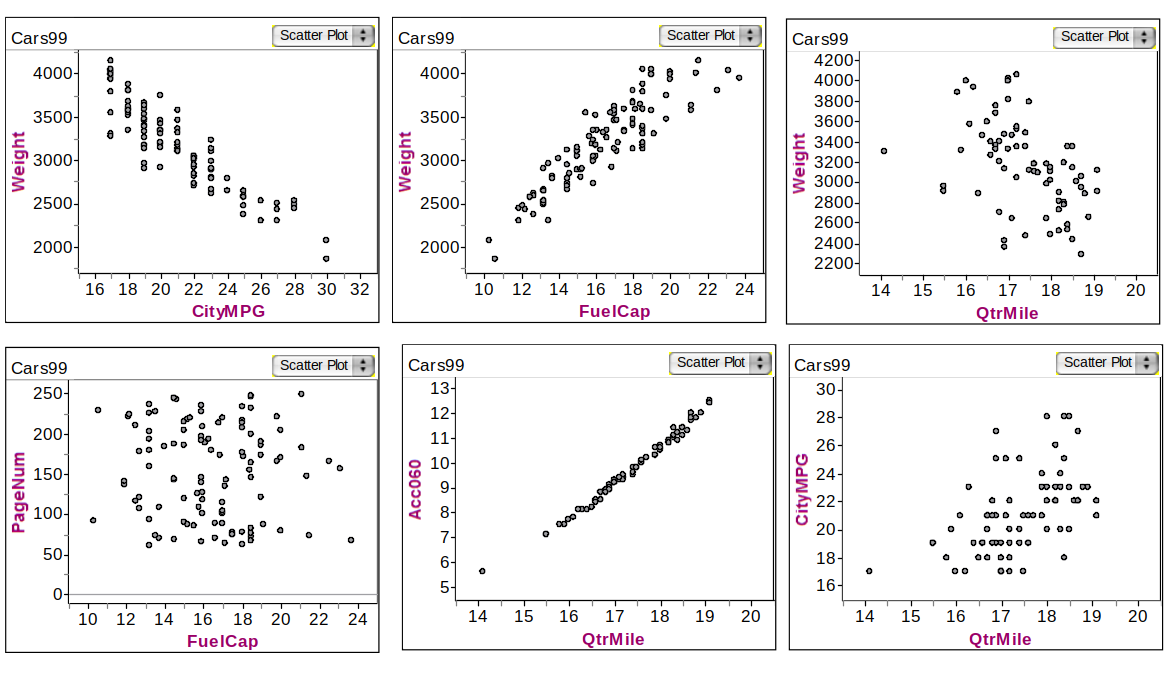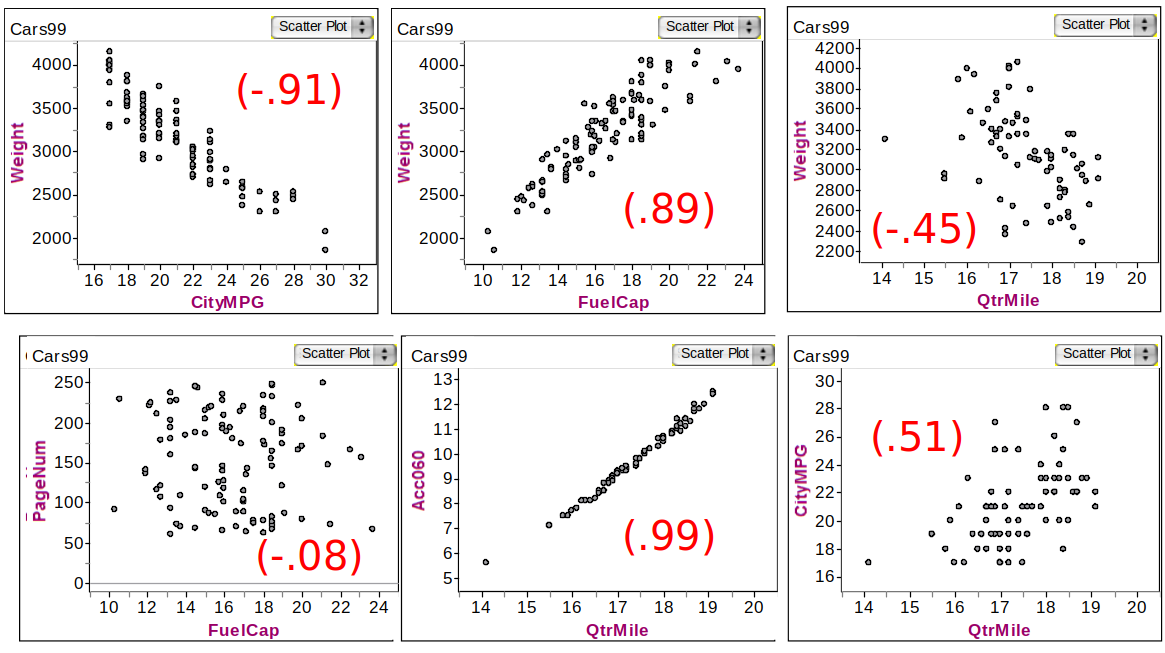Two Quantitative Variables: Association
STAT 120
Describing associations between two quantitative variables
Data: each case \(i\) has two measurements
- \(x_i\) is explanatory variable
- \(y_i\) is response variable
A scatterplot is the plot of \((x_i, y_i)\)
- form? linear or non-linear
- direction? positive, negative, no association
- strength? amount of variation in \(y\) around a “trend”
Example: Associations in Car dataset

Various Associations of quantitative variables in Cars data
Direction
positive association: as \(x\) increases, \(y\) increases
- age of the husband and age of the wife
- height and diameter of a tree
negative association: as \(x\) increases, \(y\) decreases
- number of cigarettes smoked per day and lung capacity
- depth of tire tread and number of miles driven on the tires
Correlation Coefficients
Correlation coefficient: denoted \(r\) (sample) or \(\rho\) (population)
- Strength of linear association
- \(r\approx \pm 1:\) strong
- \(r\approx 0:\) weak
- Direction of linear association
- \(r > 0:\) positive
- \(r < 0:\) negative
Correlation can be heavily affected by outliers. Plot your data!
R-code:
Car Correlations

Correlations of various variables in Cars data
Linear Regression
Goal: To find a straight line that best fits the data in a scatterplot
The estimated regression line is \(\hat{y} = a + bx\)
- x is the explanatory variable
- \(\hat{y}\) is the predicted response variable.
Slope: increase in predicted \(y\) for every unit increase in \(x\) \[ b = \frac{\text{change }\hat{y}}{\text{change } x} \]
Intercept: predicted \(y\) value when \(x = 0\) \[ \hat{y} = a + b(0) = a \]
Residuals
Geometrically, residual is the vertical distance from each point to the line

Presence of Outliers
Outliers can be very influential on the regression line. Remove the points and see if the regression line changes significantly

Regression line of Blood Alcohol Content (BAC) data
Regression of BAC on number of beers
Call:
lm(formula = BAC ~ Beers, data = bac)
Residuals:
Min 1Q Median 3Q Max
-0.027118 -0.017350 0.001773 0.008623 0.041027
Coefficients:
Estimate Std. Error t value Pr(>|t|)
(Intercept) -0.012701 0.012638 -1.005 0.332
Beers 0.017964 0.002402 7.480 2.97e-06 ***
---
Signif. codes: 0 '***' 0.001 '**' 0.01 '*' 0.05 '.' 0.1 ' ' 1
Residual standard error: 0.02044 on 14 degrees of freedom
Multiple R-squared: 0.7998, Adjusted R-squared: 0.7855
F-statistic: 55.94 on 1 and 14 DF, p-value: 2.969e-06Regression line of Blood Alcohol Content (BAC) data
Slope, \(b= 0.0180\):
Estimatecolumn andBeersrow
Intercept, \(a = -0.0127\):
Estimatecolumn andInterceptrow
Regressing BAC on number of beers
\[ \widehat{BAC} = -0.0127 + 0.0180(Beers) \]
Slope Interpretation?
- Each additional beer consumed is associated with a \(0.0180\) unit increase in BAC
y-intercept Interpretation?
- Predicted BAC with 0 beers consumed
Regressing BAC on number of beers
If your friend drank 2 beers, what is your best guess at their BAC after 30 minutes? \[\widehat{BAC} = -0.0127 + 0.0180(2) = 0.023\]

Regressing BAC on number of beers
Find the residual for the student in the dataset who drank 2 beers and had a BAC of 0.03. The residual is about \(y - \hat{y} = 0.03 - 0.023 = 0.007\)

R-squared
R-squared is proportion (or percentage) of variability observed in the response y which can be explained by the explanatory variable x.
\(R^2 = r^2\) in simple linear regression model (One explanatory variable)]
BAC : \(R^2 = 0.7998\)
- The number of beers consumed explains about 80.0% of the observed variation in BAC
- What factors (variables) besides number of beers drank might explain the other roughly 20% of variation in BAC?
R-squared
Called Multiple R-squared in the summary output
Call:
lm(formula = BAC ~ Beers, data = bac)
Residuals:
Min 1Q Median 3Q Max
-0.027118 -0.017350 0.001773 0.008623 0.041027
Coefficients:
Estimate Std. Error t value Pr(>|t|)
(Intercept) -0.012701 0.012638 -1.005 0.332
Beers 0.017964 0.002402 7.480 2.97e-06 ***
---
Signif. codes: 0 '***' 0.001 '**' 0.01 '*' 0.05 '.' 0.1 ' ' 1
Residual standard error: 0.02044 on 14 degrees of freedom
Multiple R-squared: 0.7998, Adjusted R-squared: 0.7855
F-statistic: 55.94 on 1 and 14 DF, p-value: 2.969e-06Adding a categorical variable (confounding variable)

Visually split the data by Sex. Potentially find different trends.
Adding a categorical variable (confounding variable)

Visually infer difference in Sex in terms of correlation or intercepts
Adding a categorical variable: stats by group
Can also use filter function available under dplyr package to divide responses into the groups of interest
Outliers: Average SAT by state
library(dplyr)
sat <- read.csv("https://math.carleton.edu/Stats215/RLabManual/sat.csv")
sat.MW <- filter(sat, region == "Midwest") # just MW states
cor(sat.MW$math, sat.MW$verbal)[1] 0.9731605
Call:
lm(formula = math ~ verbal, data = sat.MW)
Coefficients:
(Intercept) verbal
-23.584 1.047 Correlation = 0.9732, Regression Slope = 1.0469, R-squared = 94.7%
Outliers: Average SAT by state, excluding Indiana and Ohio
library(dplyr)
# Find the rows where 'verbal' is less than 550 using filter
filtered_data <- filter(sat.MW, verbal < 550)
# Exclude data corresponding to specific indices and calculate correlation
filtered_sat_MW <- sat.MW %>% slice(-c(2, 10))
cor_result <- cor(filtered_sat_MW$math, filtered_sat_MW$verbal)
sat.lm.noIO <- lm( math ~ verbal, data=sat.MW, subset = -c(2,10))
sat.lm.noIO
Call:
lm(formula = math ~ verbal, data = sat.MW, subset = -c(2, 10))
Coefficients:
(Intercept) verbal
6.1453 0.9956 Group Activity 1

- Please download the Class-Activity-6 template from moodle and go to class helper web page
20:00